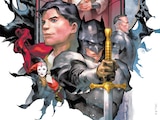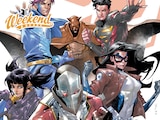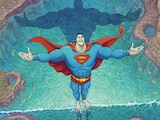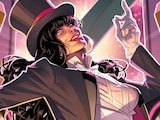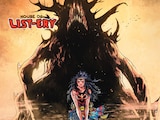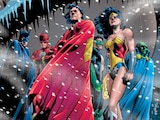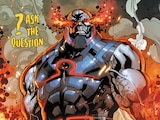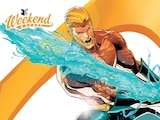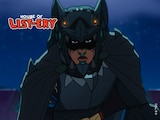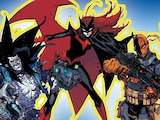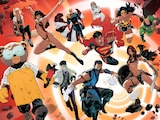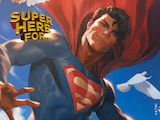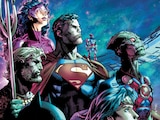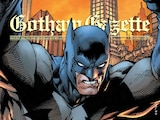Black Lightning, Thunder, Mal and Karen Duncan, Renee Montoya and Katana aren’t the biggest names on the DC roster…which is exactly what makes them ideal leads for The Other History of the DC Universe, the long-awaited five-issue miniseries from writer John Ridley and artists Giuseppe Camuncoli and Andrea Cucchi.
The series—with a title that deliberately references 1986’s similar-in-format History of the DC Universe—presents a timeline of iconic DC moments from the perspective of characters from traditionally marginalized groups. The first issue of the bimonthly series, in stores this week, stars Black Lightning, a character with major personal significance to Ridley.
Ridley, the Academy Award-winning screenwriter of 12 Years of Slave, has written comics before, including two volumes of The American Way. But as he discusses in this interview, this series marks his first time writing in the DC Universe, and he relished the opportunity to instill hope and humanity to some often-overlooked DC characters.

This series was first announced January 2018. Do you think the current state of the nation and the world has made this story even more timely than it would have been a couple years ago?
Yes and no. Obviously the things that are right in front of us, they inform how we see everything that’s around us. But whether this had come out in the wake of Trayvon Martin, in the wake of Ferguson, in the wake of what happened in Baltimore—just think about how regularly we find ourselves looking at these issues.
And that’s just for me as a Black man of a certain age. But we have characters that are dealing with issues of identity and inclusion that are gender issues, that are issues from the LGBTQ community. This is a series that would have shouldered a certain level of importance at any time. But certainly in the moment that we find ourselves in, where it feels like there’s so much weight being put on the scales, I hope it’s material that meets the moment.
You’ve written stories for DC before, but this is your first time writing DC characters in the DC Universe. How has that experience been for you, both as a DC fan, and also given this is such a unique type of story?
In some ways it was coming full circle. When I was a kid, I wasn’t a very good student, my mom—who was a teacher—really struggled to get me to read at all. One day, my parents found out that I liked reading comic books. “Great, if you read them, we’ll buy them.” That was my first introduction to reading on a regular basis. That was very important to me—a way to engage in reading and storytelling.
But I also remember when Black Lightning first came out, and what an impact that was for me as a young kid of color, to see a Black man as a hero. A Black man standing up for what was right. A Black man who in his other identity was a teacher, the way my mom was a teacher.

To be able to track a lot of my personal trajectory—to wanting to be a storyteller, to becoming a storyteller, to finally having the opportunity to tell stories in the DC Universe—it was humbling. It made me want to be all the more honorific to the men and women who came before me and inspired me. It’s been remarkable.
Black Lightning is now the star of a TV show, but he—and each of the characters featured in this series—haven’t traditionally been considered A-list. What has it been like to dig into characters who haven’t always gotten a chance to be in the spotlight?
What’s it like? Honestly, pick an adjective: it’s been great, it’s been frustrating, it’s been invigorating, it’s been thought-provoking. Some of these characters, you read them and think, “Wow, this character should have been a lead character, and it would have been amazing.” More than anything, I’m just appreciative to have the opportunity to revisit these characters and look up stories I remember from when I was much younger.
We wanted to approach it as though it were a real, true timeline. The timeline actually begins in the late 1960s with Jefferson Pierce talking about his childhood, and then taking it all the way to Anissa Pierce, where her story concludes around 2005 or 2006. It’s treated as real history. Each of these characters reflects a particular decade: ‘60s, ‘70s, ‘80s, ‘90s and the early 2000s.
More than anything, I wanted it to be hopeful. I wanted to focus on successes. I wanted to focus on relationships. I wanted to focus on these various individuals—even though they may be tasked with their own challenges, together as people, we always rise.

Curious to hear more about the format of the series, which is a mix of prose and illustration. What made that the best way to tell The Other History of the DC Universe?
It’s definitely prose. It’s different than sequential dialogue—it’s not spot art, it’s not sequential art. Cammo did a masterful job creating true flow for the book, from one moment to the next over time.
In terms of the writing, I really approached it as though it were an oral history; as though I had the opportunity to sit down with these characters and really ask them about their lives, their relationships, their successes, their failures. It really was trying to treat these characters as though they were very real people.
Speaking of Giuseppe Camuncoli, what was your experience collaborating with him, especially given the unconventional approach to illustrating this story?
It was the best kind of collaboration. It’s one thing to sit and write as a storyteller, but in the graphic novel space, so much of it is about that art, that look, that feel, the representation of these characters. Cammo is an artist in his own right, but he also has an uncanny ability to take moments and iconic artwork that existed and recreate it, but also give it its own individual identity.
We were really asking a lot of Cammo: to interpret what was on the page, to give it its own flow and feel. Sometimes having that much freedom is more of a challenge. “How do you feel about this?” “What stirs your emotion and your passion?” Cammo was able to do all of that. To have his own ideas. To look at past artwork. To make it fresh. To decide what the flow was going to be. I’m deeply appreciative of Cammo for his hard work over two and a half years.
The Other History of the DC Universe #1 by John Ridley, Giuseppe Camuncoli and Andrea Cucchi Is now available in print and as a digital comic book.

